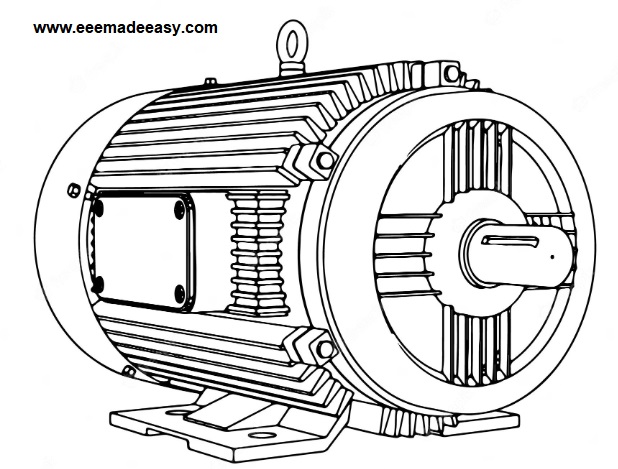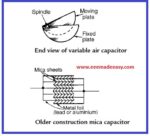DC Machines: DC Machines are the Electrical Machines those works on DC Supply. An electrical machine is an electromechanical energy conversion device. The device which converts electrical energy in to mechanical energy is called a motor. The device which converts mechanical energy in to electrical energy is called a generator.
Classification of electrical machines
D.C generator
D.C generator is a machine which converts mechanical energy in to electrical energy. Direct –current generators are used to supplypower for radio equipment, for battery charging
for electrolytic cells etc. a disadvantage common to all d.c machines is the complexity of design, mainly due to the usage of brushgear. This brush gear can also cause sparking.
A d.c machine consists essentially a stationary part, called the field structure and a rotating part called, the armature.
D.C Machines Principle of operation:
D.C generator is based on the principle that whenever magnetic flux is cut by a moving conductor, an e.m.f is induced in the conductor as per Faraday’s laws of electromagnetic induction. The e.m.f so induced is an alternating e.m.f. it is made unidirectional with the help of commutator and brushes. This e.m.f causes the flow of current in the external circuit if the circuit is closed.
The direction of induced e.m.f is given by Fleming’s right hand rule. Stretch out the right hand with first finger, middle finger and thumb mutually perpendicular to each other. If the first finger points in the direction of flux, and thumb in the direction of motion of the conductor, then the middle finger will point in the direction of the induced e.m.f.
Constructional details of D.C Machines
The main parts of a d.c machine (a generator or a motor) are described below.
1)Yoke:-
It is the outermost cylindrical part of the machine. The yoke is made of cast iron or cast steel or forged steel. The yoke acts as the supporting frame for the machine and also completes the path of the main magnetic flux. In small d.c machines, yoke is made up of cast iron. In large d.c generators, the yoke is made of cast steel from the consideration of better magnetic properties.
2)Poles:-
The pole consists of pole core and pole shoe. The field coil is wound on the pole core. The poles are made of cast steel or forged steel. In some machines, poles are made from laminated sheet steel. The main functios of the pole shoe are (a) it supports the field coil. (b) it spreads out the magnetic flux in the air gap. (since pole shoe is of large cross section, it reduces the reluctance of the magnetic path.
3)Field coils:-
The field coils are wound on pole cores. They are connected in series and the connections are arranged so that due to the flow of current in these coils alternate N and S poles are made. The field coils are made from enameled copper wire.
4)Armature:-
The armature is that part of the d.c machine where an e.m.f is induced as it rotates relative to the main field. The armature consists of the toothed core, a winding dropped in the core slots, and a commutator mouted on the armature shaft. The armature core is composed of silicon- steel laminations. The armature winding consists of sections or coils.
5)Commutator:-
The commutator, which is a typical component of d.c machines, is a hollow cylinder. The commutator is made up of wedge shaped segments of hogh conductivity hard drawn or copper forged copper. The segments are insulated from each other by thin layer of mica. The function of the commutator is to convert the e.m.f induced in the armature conductors in to unidirectional voltage across the load impedance.
6)Brushes:-
The function of the brush is to collect current from the rotating commutator and deliver it to the external load impedance. The brushes are made of carbon. The brushes are mounted in a box type of brush holder and are held on the commutator by a spring.
Simple d.c generator
The fig. gives the basic structure. When a coil is rotated in a uniform magnetic field, an alternating emf is generated across the terminals 1 and 2 of the coil. If a unidirectional current is desired in the external circuit, the two ends of the coil ABCD are connected to the two segments C1 and C2 which are insulated from each other. When C1 is positive, the brush B1 makes contact with it. But for the other half rotation, of the coil, the segment C2 becomes positive and now this makes contact with the brush B2. Thus, we see that the brush remains positive all the time, and hence a unidirectional current results in the external circuit as shown below.
The current in the external circuit is unidirectional. But its strength varies considerably. It raises and falls between zero and maximum for each half rotation of the coil. This defect of having large variations in the unidirectional e.m.f (or current) can be overcome by having more coils on the rotor.
Types of D.C generator
D.C generators are generally classified according to the method used for field excitation. Thus, they can be classified as
1.Separately excited generator
2.Self excited generator
- DC Machines Questions and Answers|DC Machines MCQ
- Armature Reaction in DC Machines|Cross Magnetization and Demagnetization
- Armature Reaction MCQ|DC Generator MCQ Questions|DC machines
- Synchronous Machines Notes and MCQ’s
Electrical Machines Best Books
| Sl no. | Book Title | Author | Buy Link |
|---|---|---|---|
| 1 | Textbook Of Electrical Technology : Ac And Dc Machines (volume – 2) | B L Theraja, AK Theraja | check price |
| 2 | Theory & Performance of Electrical Machines | J.B. Gupta | check price |
| 3 | Electrical Machines | by V.K Mehta, Rohit Mehta | check price |
| 4 | Electric Machines | PS Bimbhra | check price |
| 5 | Electrical Machines | S.K. Bhattacharya | check price |
- Environment MCQ for RRB JE CBT 2|Objective Questions Environment for Competitive Exams
- RRB JE CBT 2 Computer Awareness Book Arihant|Objective Computer Awareness Book 2025
- RRB JE CBT 2 Exam Date 2025 Postponed|RRB JE CBT 2 Exam Date
- [PDF]RRB JE Result 03/2024 Cut off, Selected no of candidates for all regions
- [PDF]Final Answer Key Junior Instructor Mechanic Agricultural Machinery|643/2023 Solved Question paper
- Acoustics MCQs|Industries Extension officer|IEO 2025
- LASER MCQs| Industries Extension officer|IEO 2025
- Practical Types of Capacitors
- [PDF] Syllabus JUNIOR INSTRUCTOR MECHANIC AGRICULTURAL MACHINERY|643/2023 Syllabus Kerala PSC
- [PDF] Syllabus JUNIOR INSTRUCTOR WOOD WORK TECHNICIAN|674/2023 Syllabus Kerala PSC
- [PDF] Syllabus JUNIOR INSTRUCTOR MECHANIC CONSUMER ELECTRONIC APPLIANCES|670/2023 Syllabus Kerala PSC
- [PDF] Junior Instructor Hospital Housekeeping| 646/2023 syllabus Kerala PSC













